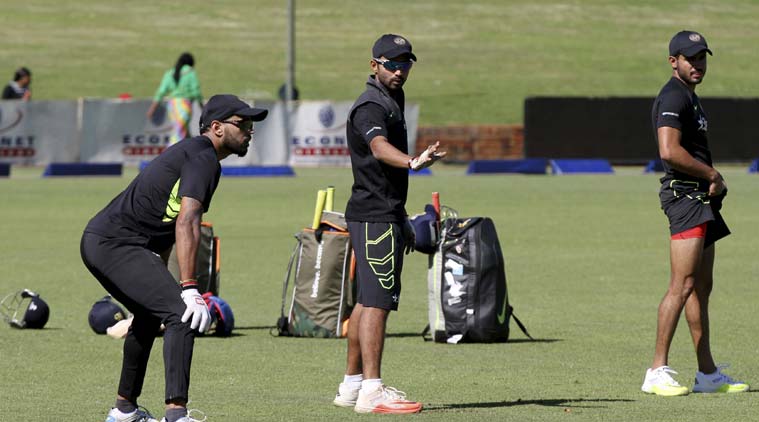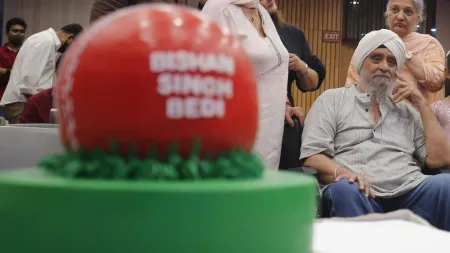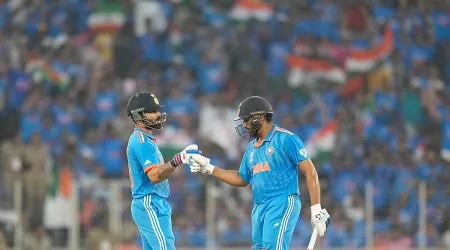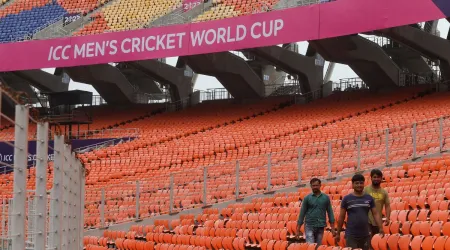- India
- International
India tour of Zimbabwe: Reserves game for African safari
Second-string Indian team, led by a new captain Ajinkya Rahane, set to face an eager Zimbabwe in the first One-dayer in Harare.
 Ajinkya Rahane (centre) during a practice session in Harare on Thursday. India face Zimbabwe in the first of the three ODIs on Friday. (Source: Reuters)
Ajinkya Rahane (centre) during a practice session in Harare on Thursday. India face Zimbabwe in the first of the three ODIs on Friday. (Source: Reuters)
“Lo and behold, to your right. Ladies and gentlemen, please take in the sight.”
The pilot has spoken in rhymes. The dull in-flight entertainment has been sacrificed. And all passengers aboard the Ethiopia-Zambia-Zimbabwe carrier have slid one way to catch a glimpse of the tallest structure in Africa. The tallest free-standing mountain in the world. Mt. Kilimanjaro.
There it stands, a black beauty with an icy head, between what we know to be Kenya and Tanzania. Alone and daunting, like a pimple on an otherwise freckle-free face. Alone and daunting, like a recital of poetry on a plane. “Great day to fly. Not a cloud in the sky. Happens only in July,” the captain adds, laughing a jazz laugh to self.
“Enjoy your Kilimanjaro Moment.”
Kilimanjaro Moment. Capital ‘K’, capital ‘M’. Otherwise defined as a stellar anomaly that occurs only here in Africa. A present tense that breaks all relations from its immediate past and immediate future.
Just like this monolith rising and falling exponentially, bang in the middle of a barren bush. More to the point, just like an African cricket team knocking out giants with regularity, bang in the middle of a most irregular and torrid decade.

To fully understand why a fortnight of cricket that occurred five years ago in Zimbabwe was the country’s Kilimanjaro Moment, consider the following. Between July 10, 2005 and today, July 9, 2015 — a full decade — the nation won all of seven one-day internationals against other full-member ICC countries; not counting Bangladesh that is. In the first half of the said decade, Zimbabwe managed all of two wins, both against the West Indies, one at home and one away. This was the worst epoch of the game in Zimbabwe, an epoch that witnessed everything from white rebel groups, player exodus and the snatching away of their Test status.
In the second half of the said decade, following much rebuilding (which included the returning of their Test badge), Zimbabwe still scored just two ODI wins against Test-playing nations that aren’t Bangladesh. That sweet taste of victory was relished in successive years — a win over Pakistan in 2013 (Bulawayo) and a shock win over a full-strength Australia in 2014 (Harare).
That’s four wins of note in 3635 days. Or, a win of note every two-and-a-half years.
But in the pulsating heart of this desert, there was once something far more startling than an oasis. There was a deluge. Five years ago, a Zimbabwean winter turned into spring when their below-par cricket team won thrice against Test playing nations, all in the space of 14 days. Or, a win of note every four-and-a-half days.
In a triangular series of two rounds, they beat India in the first round, and India again in the second.
Then they walloped Sri Lanka in the second round to qualify for the final, in turn knocking India out of the competition. Hamilton Masakadza, the team’s prodigal son-of-soil, made winning scores in each of these three wins — 46, 62 and 66. How much did it mean to him and his country? Read on.
A few hours after the third of those knocks, well into a cold and damp winter evening, I found Masakadza at The Keg inside the Harare Sports Club. The Keg looks like a sports bar, but in reality is an institution in Harare. Here within its walls, you find locals who aren’t even remotely interested in cricket. They visit for the varied brews on offer, and find themselves in the periphery of an international match. Sipping beer by the boundary ropes, inches away from Virat Kohli at third man.
Anyway, on that particular evening, I walked up to Masakadza as he sat there on a bar-stool, still in his Zim reds, giggling at his drink. “If I invite you to my wedding, will you come?” he asked. Of course, I replied, “but I leave a day after the final.”
“No worries,” the man of the hour said. “I’m getting married a day before the final. Tomorrow.”
At the altar, he told the audience and his beautiful wife Vimbai: “We couldn’t have done this at a better time. The whole country seems to be happy for me. For us. For Zimbabwe.”
A peak scaled
Zimbabwe were beaten in the final by Sri Lanka. But the peak had been scaled already, albeit with supplemental oxygen in the form of a second-string India. Still, a summit is a summit and a loss to Zimbabwe is a loss to Zimbabwe. The selectors back home should have gotten the message loud and clear then — “Don’t insult a proud cricket nation and its fans with reserve players.” But they did it again three years later and won 5-0. This time in 2015, though, it may not be so easy.
Over just the last two series, 2010 and 2015, as many as ten Indians have made their ODI debut on this soil. In no particular order they are R Ashwin, Umesh Yadav, Naman Ojha, Ambati Rayudu, Jaydev Unadkat, Cheteshwar Pujara, Mohit Sharma, Ashok Dinda, Vinay Kumar and Pankaj Singh. And in all likelihood, Karnataka’s Manish Pandey and Punjab’s Sandeep Sharma will do the same this time around.
But it isn’t just Sharma and Pandey who’ll feel the pressure of donning the India blue. Each of the remaining 13 players on this tour too are experiencing some sort of rebirth in this Indian team — including captain Ajinkya Rahane, who was dropped from the final two matches of the Bangladesh series that India spectacularly messed up last month.
Apart from Rahane, there’s of course Harbhajan Singh, who last played an ODI for India in 2011. And there’s Murali Vijay, who hasn’t added to his tally of 14 ODIs since 2013. For one-ODI-old Kedar Jadhav, this series will pretty much count as a second debut. As it will be for wicketkeeper-elect Robin Uthappa, who apart from featuring in one ODI in 2014, was forgotten by our selectors way back in 2008.
Compare that to Zimbabwe, who, despite having lost Brendan Taylor to England’s domestic league, wear the look of a solid and settled unit. This year, apart crossing the finish line (they have beaten just Afghanistan in 2015), Zimbabwe have made all the right noises of finally turning the corner.
That corner could’ve turned at the World Cup, when they nearly chased down Ireland’s 332, falling just six runs short. That corner could’ve been flipped in their last Cup match, when they had India reduced to 92/4 after posting 287 in Taylor’s swan song. More corners, more chances. Agreeing to tour Pakistan when no other team does shows they’re desperate to rub shoulders with the big boys. That desperation showed when they posted 334/5 in a chase of 375 in the first ODI in Lahore. That desperation glowed when they agreed to play the final ODI despite a suicide bomber blowing himself up outside the Gaddafi’s gate during the second game.
Now, starting Friday, they are up against India. Another second string Indian side. And were the hosts to finally turn that elusive bend, they’ll be the first to tell you that they’d seen this coming. Quite like climbing the tallest peak of the Alps after spending days on the range. Nothing at all like a standalone Kilimanjaro Moment.
Live on Ten Cricket: 12:30 pm
Get latest updates on IPL 2024 from IPL Points Table to Teams, Schedule, Most Runs and Most Wickets along with live score updates for all matches. Also get Sports news and more cricket updates.










































